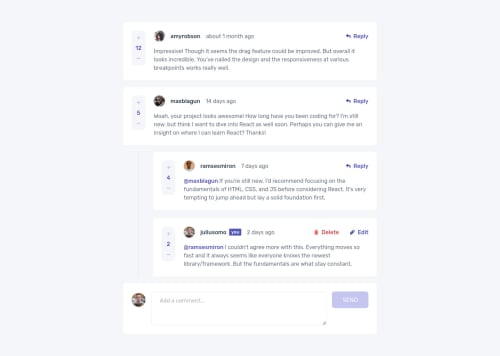Interactive Comments w/ React, Styled Components, & Framer Motion

Solution retrospective
I don't spend as much time working with React on the web these days (Vue/Svelte on the web; React Native on mobile), so I thought it'd be a good time to shake the rust off.
This project was mostly just for fun, but open to constructive feedback!
Some neat stuff stuff:
- Comments are stored in localStorage. I set up a storage listener to update them when changed in another tab. The original, nested tree structure felt natural in terms of how I wanted to render the UI, but was difficult to update immutably. I flattened out the data for manipulation and storage, and then computed the tree from that to be used for rendering; best of both worlds
- Animations with Framer Motion, smooth scrolling to edit forms that open off-screen, etc
- Date distance formatting using date-fns. I've been using date-fns at work quite a bit lately, and I really like it. The label is recalculated about every 10 seconds, which adds a fun effect to recently-added comments. If this were a real system, I'd probably only recalculate the labeling for dates before a certain cutoff or would alter the interval to run less frequently.
- I wrote a couple fun utilities for styled-components
- A media query generator. It reduces a record of mediaQueryName->minWidth to a record of mediaQueryName->cssFunction. Felt nicer to use than plain media queries. I would have liked to proxy the tagged template arguments to
cssdirectly, but I found that when I did that, I lost syntax highlighting and prettier formatting for styles in the media query. Kind of a silly tradeoff... but oh well. color, which is a simple, well-typed, higher-order-function for plucking colors out of the theme. Rather than writing stuff like${props => props.theme.colors.moderateBlue}everywhere, I was instead able to write things like${color("moderateBlue")}. Trivial, but felt a lot nicer to write.
- A media query generator. It reduces a record of mediaQueryName->minWidth to a record of mediaQueryName->cssFunction. Felt nicer to use than plain media queries. I would have liked to proxy the tagged template arguments to
Getting the animations to do (mostly) what I wanted was probably the toughest (self-imposed) part of this challenge. I don't have a very good intuition for Framer Motion at this point, so I spent a lot of time struggling with the docs. Would be interested to learn if a) there's a way to simplify the animations that I've added and/or b) how I might go about animating between the view and edit states; couldn't quite figure that one out.
Some of the code I had to write to work around various interactions between browser quirks, focus management, scrolling, and animations felt pretty hacky. In the end, I think things work pretty well, but I'm not sure how those hacks would scale in a larger project with more complex interactions
Please log in to post a comment
Log in with GitHubCommunity feedback
No feedback yet. Be the first to give feedback on Jacob's solution.
Join our Discord community
Join thousands of Frontend Mentor community members taking the challenges, sharing resources, helping each other, and chatting about all things front-end!
Join our Discord